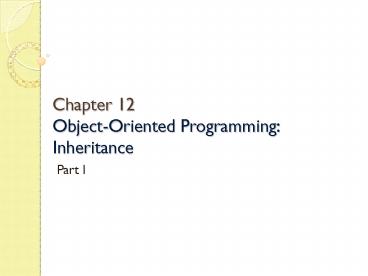Chapter 12 Object-Oriented Programming: Inheritance - PowerPoint PPT Presentation
1 / 13
Title:
Chapter 12 Object-Oriented Programming: Inheritance
Description:
More specialized group of objects than the base class. Behaviors inherited from base class ... Includes cars, trucks, boats, bicycles, etc. Derived class: Car ... – PowerPoint PPT presentation
Number of Views:262
Avg rating:3.0/5.0
Title: Chapter 12 Object-Oriented Programming: Inheritance
1
Chapter 12 Object-Oriented Programming
Inheritance
- Part I
2
12.1 Introduction
- Inheritance
- Software reusability
- Create new class from existing class
- Absorb existing classs data and behaviors
- Enhance with new capabilities
- Derived class inherits from base class
- Derived class (????)
- More specialized group of objects than the base
class - Behaviors inherited from base class
- Additional behaviors
3
12.1 Introduction
- Class hierarchy
- Direct base class
- Inherited explicitly (one level up hierarchy)
- Indirect base class
- Inherited two or more levels up hierarchy
- Single inheritance
- Inherits from one base class
- Multiple inheritance
- Inherits from multiple base classes
- Base classes possibly unrelated
- More details in chapter 24
4
Fig. 12.2 Inheritance hierarchy for university
CommunityMembers.
5
12.1 Introduction
- Focus on commonalities among objects in system
- is-a vs. has-a
- is-a
- Inheritance
- Derived class object can be treated as base class
object - Example Car is a vehicle
- Vehicle properties/behaviors also apply to a car
- has-a
- Composition
- Object contains one or more objects of other
classes as members - Example Car has a steering wheel
6
12.1 Introduction
- Three types of inheritance
- public
- private
- protected
7
Software Engineering Observation 12.1
- Member functions of a derived class cannot
directly access private members of the base
class. - This is for ensuring information hiding.
8
12.2 Base Classes and Derived Classes
- Base classes and derived classes
- Object of one class is an object of another
class - Example Rectangle is quadrilateral
- Class Rectangle inherits from class Quadrilateral
- Quadrilateral is the base class
- Rectangle is the derived class
- Base class typically represents larger set of
objects than derived classes - Example
- Base class Vehicle
- Includes cars, trucks, boats, bicycles, etc.
- Derived class Car
- Smaller, more-specific subset of vehicles
9
Fig. 12.3 Inheritance hierarchy for Shapes.
10
12.2 Base Classes and Derived Classes
- public inheritance
- Specify with
- Class TwoDimensionalShape inherits from class
Shape - Base class private members
- not accessible directly
- but still inherited
- Manipulated through inherited public member
functions - Base class public and protected members
- Inherited with original member access
- friend functions
- Not inherited
Class TwoDimensionalShape public Shape
11
12.3 protected Members
- protected access
- Intermediate level of protection between public
and private - protected members are accessible to
- Base class members
- Base class friends
- Derived class members
- Derived class friends
- Derived-class members
- Refer to public and protected members of base
class - Simply use member names
- Redefined base class members can be accessed by
using base-class name and binary scope resolution
operator ()
12
Example
class Student friend ostream operatorltlt
(ostream out, const Student s) public
Student(string, string) Student()
string GetName() protected string
name, id private
inherit
inherit
class GraduateStudent public Student
public GraduateStudent(string, string)
GraduateStudent() string
GetSupervisor() protected string
supervisor private
class UndergraduateStudent public Student
public UndergraduateStudent(string,
string) UndergraduateStudent()
string GetPreceptor() protected string
preceptor private
13
Example
void main() UndergraduateStudent
stu1(Joe, 00001) string name
stu1.GetName() cout ltlt stu1 ltlt
endl
Undergraduate???Student,?????public?protected?????
????
?????????

